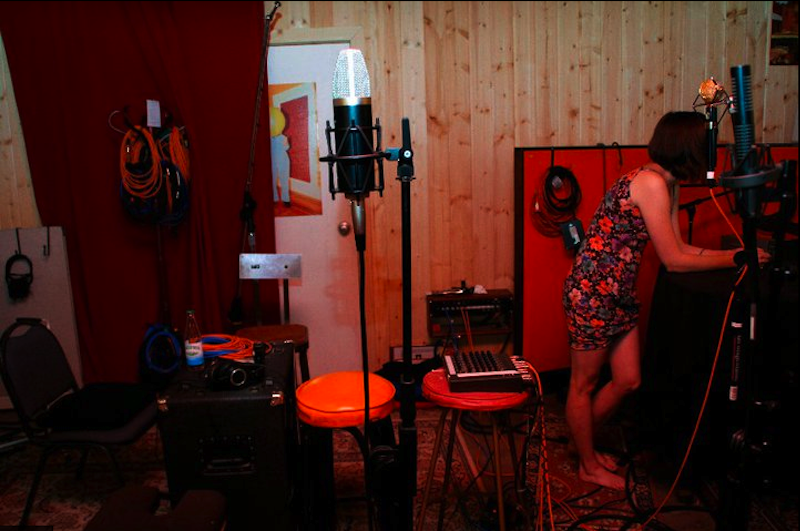Recording studios are temples of sound for those who treat music like religion. People the world over make pilgrimages to otherwise unremarkable buildings like Soulsville (Stax) and Hitsville (Motown), just to stand in the same space as the men and women responsible for so much soulful magic. These wellsprings of creativity are revered historical landmarks; concrete monuments to the summit of recorded musical brilliance. The world has changed, and so has the technology of recording and distribution, but the feeling of walking into a room where the building blocks of music (rhythm, harmony and melody), are being assembled and preserved for posterity is a rare and timeless joy.
I spent a day in New, Improved Recording Studios in Oakland, watching as Anna Ash and co-producer Joey Dosik recorded vocal harmonies and horns for Ash’s upcoming LP. Anna Ash is a 24-year-old multi-instrumentalist from Northern Michigan, now living in and restoring an Oakland ballroom, the Starline Social Club. This will be her second full-length LP, partially financed through Kickstarter and her part time job as a waitress in San Francisco. Ash’s music is folk-centric, but the most distinctive element of her sound is her unique voice.
If the hallmark of soul is the singer letting it all out, Ash is akin to a modern Esther Phillips. When she sings, she shakes, her eyes roll back and the notes flow out, over and around the melody, like skipping stones over a raging river. Sometimes, it sounds like it’s a struggle to reign it all in. Nevertheless, there’s something arresting about a voice with edges, it gives you something to grasp onto as the band soars away.
The day’s first task is to record harmony vocals for a couple of songs, beginning, appropriately, with “Holy Days.” As she warms up her voice, the back-up singers begin to take their place around the three microphones. The Rhodes, Farfisa and Hammond keyboards scattered around the room give no indication of the era, nor does anyone’s garb. Doug Stuart, also Ash’s bassist, is sporting a thick beard and newsboy cap, looking dapper, like a character from a Fitzgerald novel. Sandra Lawson Ndu looks like a long lost Pointer Sister and Christine Huacal has a distinctly nineties affectation, complete with neon jacket, large triangle earrings and a fresh pair of Nike Dunks. Dosik, from Los Angeles, is wearing a Showtime era Lakers shirt and constantly cracking jokes in between playing the chord progression on a piano and singing everyone their part.
Carlos Arredondo, the engineer, hands out headphones, and places everyone strategically, with the boys flanking the girls in a semi-circle, before retreating to the control room. Just like they’ve always done, he uses an intercom to speak with the musicians; unlike the old days, there is no tape, so takes are unlimited.
After the first few attempts the group nails it, but they keep going. I can’t tell the difference between one and the next or who is sharp or flat, and after enough passes its declared that a perfect take can be cobbled together from all of them.
It’s startling to move from the carpet-lined confines of the studio to the control room, with the giant mixer looking like the command deck of the Starship Enterprise. The sheer amount of buttons, dials and sliders is staggering, but not nearly as astounding as the clarity of sound coming through the monitors. Everything sounds so clean; it puts the onus on the performers to, well, perform, in order for everything to sound just right. Fortunately for Anna, everyone is on point and the harmonies sound soothing, like a hammock in the breeze.
As everyone sat down for dosas on a dinner break, Dosik frantically finished writing out the charts for the hired horns. His arrangements added another dash of soul to Ash’s compositions, though the proceedings weren’t quite as easy as the afternoon’s vocal session. First, recording horns is a bit more difficult than saying "everyone sing together into this microphone, and you, sing a little louder." Second, while fine musicians, these weren’t the Memphis Horns, and everyone was unfamiliar with both each other and the material.
The trio of Danny Lubin-Laden on the tube/trombone, Andy Haefner on the tenor saxophone and Will Magid on the trumpet, were however the utmost professionals, learning the songs on the spot, taking direction and stretching their chops for the seemingly endless calls of “one more take.”
As the hours wore on and the takes piled up it seemed to be a foregone conclusion that perfection was unattainable, and the best that was going to happen had already been saved to disk. Perfection, especially in music, isn’t such a bad thing to strive for, though nearly impossible to achieve and even harder to capture. The best moments are the ones that fall just short, made by people in a room combining their talents like audio alchemists turning raw expression into vinyl, preserving one moment onto a record that will outlast each and every one of us.

